= Copiapoa dealbata F.Ritter
Cactus (Paris) xiv. No. 63, 137 (1959).
Accepted Scientific Name: Copiapoa malletiana (Lem. ex Salm-Dyck) Backeb. in Backeb. & F.M.Knuth
Kaktus-ABC [Backeb. & Knuth] 280. 1936 [12 Feb 1936] Backeb., F.M.Knuth

Copiapoa cinerea subs. dealbata (Copiapoa dealbata) Photo by: Carolina González
Habit at Carrizal Bajo, 03 Atacama, Chile.
Origin and Habitat: Copiapoa dealbataSN|1322]]SN|1322]] occurs along the Chilean coast, both north and south of Carrizal Bajo, and at a point ca halfway towards Totoral, Atacama, Chile. It has a restricted range (extent of occurrence 500 km2), however the species is abundant, there is no continuing decline of the populations.
Altitude: (0–)20-500(-700) metres above sea level.
Habitat: The species is locally abundant forming groups of several individuals near the coast, in coastal hills (lomas costeras) in a very dry area on sandy alluvial and rocky soils, and desert shrubland on sandy soil. Despite the lack of rain where it lives, the extreme aridity is attenuated by the frequent, often dense, coastal fogs. It shows a recurrent pattern; usually it is overcast in the early mornings, the clouds dissipating during the late morning and returning during the late afternoons. At times this region is dominated by geophytes, which can cover expanses of the desert spectacularly. The species is sporadically collected for ornamental use, only a small portion of the plant is taken and this is not lethal. The major threats are off-road vehicles and road construction.
Synonyms:
See all synonyms of Copiapoa malletiana
back
Accepted name in llifle Database:Copiapoa malletiana (Lem. ex Salm-Dyck) Backeb. in Backeb. & F.M.KnuthKaktus-ABC [Backeb. & Knuth] 280. 1936 [12 Feb 1936]Synonymy: 10
back
Common Names include:
SPANISH (Español): Copiapoa de Carrizal (Chile), Quisco, Quisco del desierto, Copiapoa de Carrizal Bajo
Description: Copiapoa dealbataSN|1322]]SN|1322]] is a cespitose, greyish-white globular cactus, similar to Copiapoa cinereaSN|1380]]SN|1380]] but usually with longer spines. Typically Copiapoa dealbataSN|1380]]SN|1322]] has only one single spine from the areoles. The form with more spine per arela (up to 7) is known as Copiapoa carrizalensens but the two forms grows side by side and plants with few or more spines grows together in the same population.
Habit: Plants strongly branched basally, forming imposing mounds up to 1 m tall and more than 2 m wide.
Stems: Individual head, globose to short cylindrical, 6 to 16 cm in diameter, apex wool-covered. Epidermis white-dusted, covered greyish-white waxy film, but not so white like in Copiapoa cinereaSN|1322]]SN|1380]].
Ribs: (15-)21-33 more higher and acute than in Copiapoa cinereaSN|1380]]SN|1380]], slightly tuberculate and narrow between the areoles.
Areoles: Large oval, 5-9 mm in diameter, widely separated (1-2,5 cm apart) and covered with yellowish-grey or whitish-grey felt.
Spines: Copiapoa dealbataSN|1322]]SN|1322]] has mostly 1 single spine, 2–5 cm long (sometimes 1–3 smaller) straight, stiff, needle-like, black to light brown, becoming greyish white with time. Younger specimens usually have more numerous spines per areloa.
Flowers: Apical, pale yellow, scentless, 2,8-3,5 cm long and in diameter. Outer perianth segments with brown-reddish mid stripes.
Blooming: Summer. It is not unusual for copiapoa to take 6-10 years before it starts blooming, but once it does, it should every year.
Fruits: Yellowish white to reddish green, rounded, with few scales.
Seeds: Black, bumpy.
Bibliography: Major references and further lectures
1) A. Gomez Sanchez “Enciclopedia ilustrada de los cactus y otras suculentas” Mundi-Prensa Libros, 2006
2) Cactus & Succulent Journal of Great Britain 43: 59 1981
3) Riha & Subik. “The illustrated encyclopedia of cacti and other succulents” (edited by G. & K.A. Beckett) 1981
4) James Cullen, Sabina G. Knees, H. Suzanne Cubey “The European Garden Flora Flowering Plants: A Manual for the Identification of Plants Cultivated in Europe, Both Out-of-Doors and Under Glass” Cambridge University Press, 11/ago/2011
5) Clive Innes “Complete Handbook of Cacti and Succulents” Van Nostrand Reinhold Company, 01/Dec/1981
6) Stephen D. Davis, Vernon Hilton Heywood, Alan Charles Hamilton, International Union for Conservation of Nature and Natural Resources “Centres of Plant Diversity: The Americas” World Wide Fund for Nature (WWF) and ICUN - World Conservation Union, 1994
7) Edward Anderson “The Cactus family” Timber Press, Incorporated, 2001
8) David R Hunt; Nigel P Taylor; Graham Charles; International Cactaceae Systematics Group. "The New Cactus Lexicon" dh books, 2006
9) N. L. Britton, J. N. Rose “The Cactaceae. Descriptions and Illustrations of Plants of the Cactus Family.” Volume 4, The Carnegie Institution of Washington, Washington 1923
10) Faundez, L., Walter, H.E. & Saldivia, P. 2013. Copiapoa dealbata. The IUCN Red List of Threatened Species 2013: e.T152929A696219. http://dx.doi.org/10.2305/IUCN.UK.2013-1.RLTS.T152929A696219.en. Downloaded on 18 February 2016.
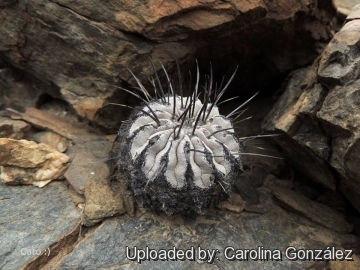 Juvenile specimen at Carrizal Bajo, 03 Atacama, Chile. (Copiapoa dealbata) Photo by: Carolina González
Juvenile specimen at Carrizal Bajo, 03 Atacama, Chile. (Copiapoa dealbata) Photo by: Carolina González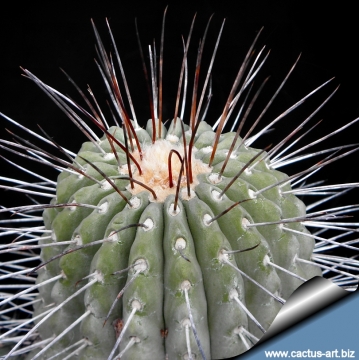 Copiapoa cinerea subs. dealbata (Copiapoa dealbata) Photo by: Cactus Art
Copiapoa cinerea subs. dealbata (Copiapoa dealbata) Photo by: Cactus Art Large clumps at Carrizal Bajo, 03 Atacama, Chile. (Copiapoa dealbata) Photo by: Carolina González
Large clumps at Carrizal Bajo, 03 Atacama, Chile. (Copiapoa dealbata) Photo by: Carolina González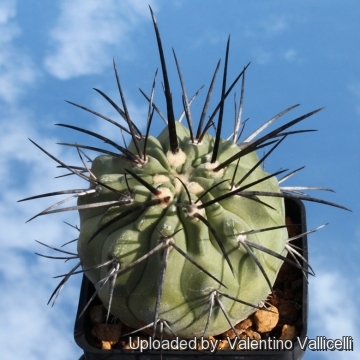 Juvenil specimen in cultivtion. (Copiapoa dealbata) Photo by: Valentino Vallicelli
Juvenil specimen in cultivtion. (Copiapoa dealbata) Photo by: Valentino Vallicelli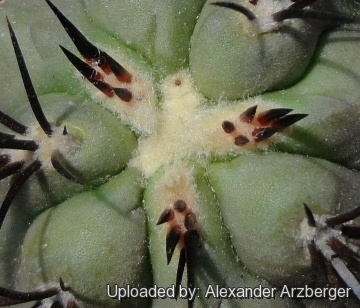 Copiapoa cinerea subs. dealbata (Copiapoa dealbata) Photo by: Alexander Arzberger
Copiapoa cinerea subs. dealbata (Copiapoa dealbata) Photo by: Alexander ArzbergerSend a photo of this plant.The gallery now contains thousands of pictures, however it is possible to do even more. We are, of course, seeking photos of species not yet shown in the gallery but not only that, we are also looking for better pictures than those already present.
Read More... Cultivation and Propagation: This cactus is kept for the beauty of its form. It is a summer grower species slow but easy to cultivate that like many cacti of the Peruvian deserts, present some problems in cultivation. It is in fact somewhat rot prone if kept in a non ventilated place.
Growth rate: It is a relatively rapidly growing and easily flowering species that will make clumps given the best conditions.
Soils: It likes very porous standard cactus mix soil, but can become too elongated if compost is too rich.
Repotting: Use pot with good drainage.
Watering: Water regularly from Spring to Autumn, but do not overwater and let the soil mix dry between waterings (Rot prone), keep dry in winter.
Fertilization: Feed with a high potassium fertilizer in summer.
Hardiness:Keep warm and dry in winter (10°C) to avoid rot. Not highly tolerant of a great deal of frost. (Frost tolerance 0°C)
Exposition: Requires full sun or light shade and careful watering to keep plant compact with strong coloured spines. Tends to bronze in strong light, which encourages flowering and heavy spine production. It must be protected from excessive heat and sun in summer.
Uses: It is an excellent plant for container growing. It always looks good and stays small. It look fine in a cold greenhouse and frame or outdoor in a rockery.
Pests & diseases: It may be attractive to a variety of insects, but plants in good condition should be nearly pest-free, particularly if they are grown in a mineral potting-mix, with good exposure and ventilation. Nonetheless, there are several pests to watch for:
- Red spiders: Red spiders may be effectively rubbed up by watering the infested plants from above.
- Mealy bugs: Mealy bugs occasionally develop aerial into the new growth among the wool with disfiguring results, but the worst types develop underground on the roots and are invisible except by their effects.
- Scales: Scales are rarely a problem.
It is wise to treat your whole collection with a systemic insecticide twice a year in spring and autumn.
- Rot: Rot is only a minor problem with cacti if the plants are watered and “aired” correctly. If they are not, fungicides won't help all that much.
Propagation: Seeds (or offsets if available) or by grafting onto a strong grafting stock like Selenicereus sp. Such grafted seedlings can be successfully cultivated for years. Grafting is often used to speed growth rate and to create a back-up to plants in collection. Seeds germinate in 7-14 days at 21-27° C in spring, remove gradually the glass cover as soon the plants will be well rooted (ca 1-2 weeks) and keep ventilated, no full sun for young plants!
Your Photos
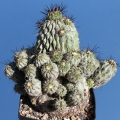
by Valentino Vallicelli
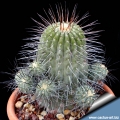
by Cactus Art

















